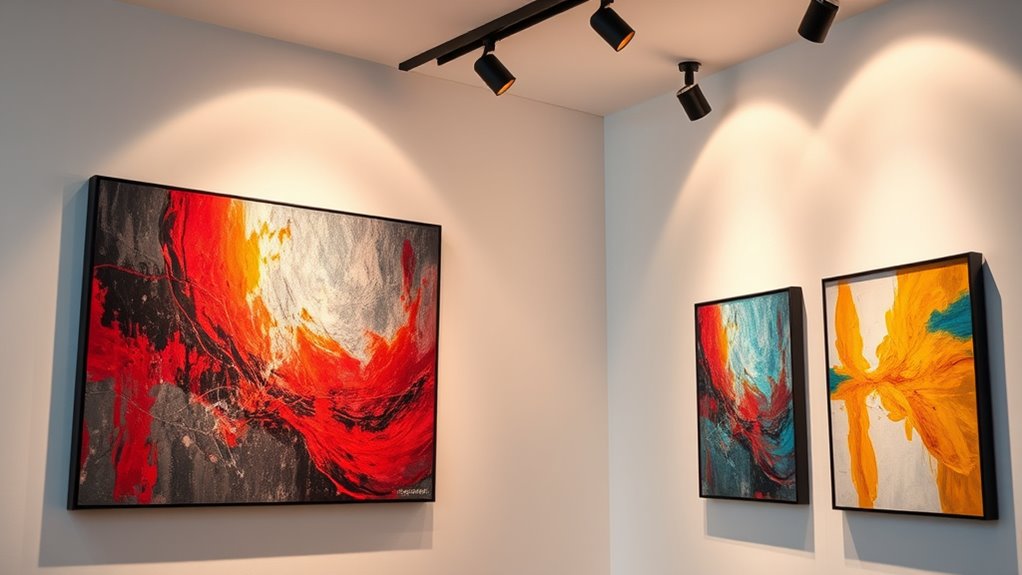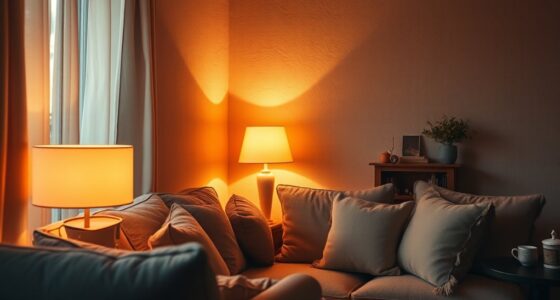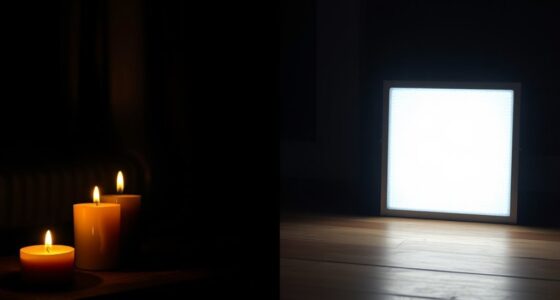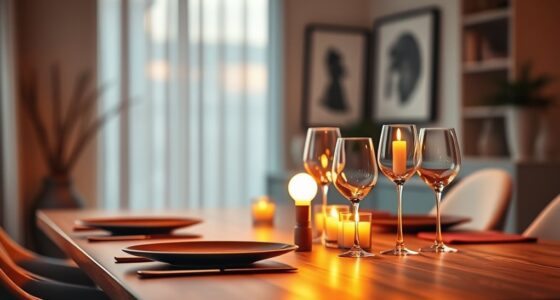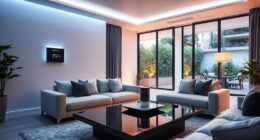To highlight your art without glaring walls, focus on directional lighting like wall sconces installed slightly above eye level and angling downward to prevent reflections. Use matte-finished fixtures or diffused LED strips behind molding or frames to create soft, even illumination. Incorporate dimmable lights to adjust brightness as needed, and consider employing perimeter LED strips to add a subtle glow without distraction. Keep these tips in mind, and you’ll discover more ways to perfect your lighting setup.
Key Takeaways
- Install wall sconces slightly above eye level, angling downward to minimize reflections and glare on artwork.
- Use matte-finish fixtures and shades to reduce unwanted shine and diffuse light evenly.
- Position LED strip lights behind molding or frames for subtle, even highlighting without direct glare.
- Employ dimmable lighting to adjust intensity, creating the perfect balance between illumination and glare reduction.
- Focus light angles on artwork’s reflective surfaces, avoiding direct hits to prevent glare and enhance visual focus.
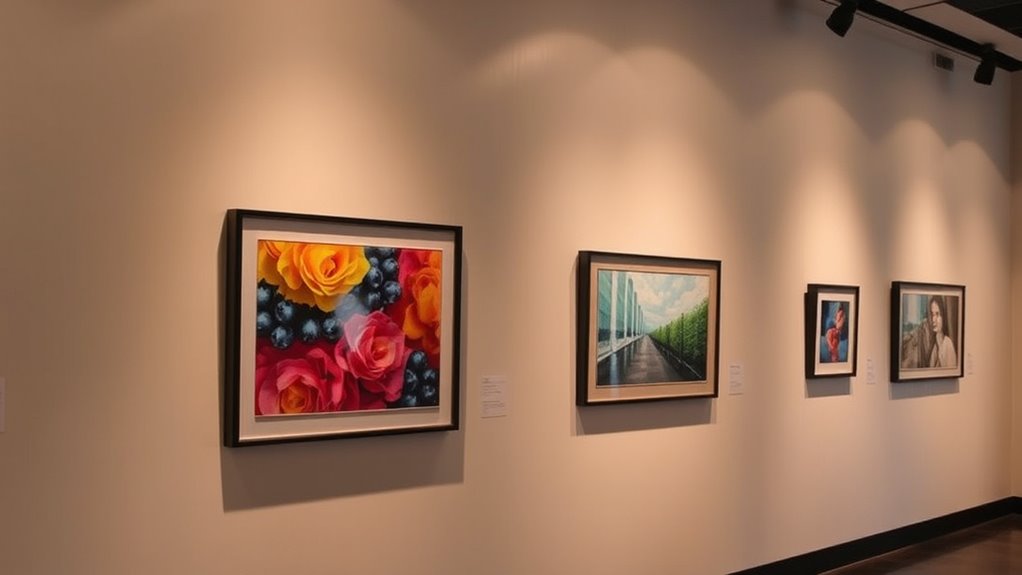
Accent lighting can dramatically transform a space by highlighting its best features and creating a warm, inviting atmosphere. When you want to showcase artwork without causing glare, choosing the right lighting techniques becomes essential. Wall sconces and LED strips are versatile options that can help you achieve this goal effectively. Wall sconces, for instance, are perfect for accentuating paintings or sculptures because they direct light at an angle, reducing harsh reflections and shadows. By installing sconces slightly above eye level and angling them downward, you minimize glare while casting a gentle glow that enhances your art pieces. They also add a touch of elegance and can serve as decorative fixtures, blending form and function seamlessly.
LED strips, on the other hand, offer flexible lighting that you can customize to suit your space. You can conceal LED strips behind crown molding, along the edges of shelves, or underneath picture frames to create an even, diffused light that emphasizes your artwork without overwhelming it. Since LED strips are low-profile and can be dimmed, you have full control over the intensity of the light, allowing you to set the perfect mood and avoid any unwanted reflections on glossy surfaces. They also come in various color temperatures, so you can choose warm white for a cozy feeling or cooler tones for a more modern, vibrant look. Using LED strips along the perimeter of a display wall gives your art a subtle halo effect, drawing attention without distracting from the piece itself.
To maximize your accent lighting, consider layering your light sources. Combine wall sconces with LED strips for a balanced effect—sconces illuminating the overall space and LED strips providing targeted highlights. This approach prevents hotspots and ensures your art is evenly lit. When positioning your fixtures, keep in mind the angle of light and the reflective qualities of your artwork. Matte finishes are less prone to glare, but for glossy or glass pieces, softer lighting angles work best. Using dimmable fixtures enables you to fine-tune the ambiance during different times of day or for various occasions, making your art truly stand out while maintaining a comfortable environment.
Frequently Asked Questions
How Do I Choose the Right Accent Lighting Fixtures?
When choosing the right accent lighting fixtures, you need to contemplate bulb types and fixture styles. Opt for LED or halogen bulbs for bright, focused light that highlights art without glare. Select fixture styles like adjustable track lights or picture lights to direct illumination precisely. Avoid overly bulky fixtures that can distract from your artwork. By balancing bulb types and fixture styles, you can beautifully showcase your art without causing glare or distraction.
Can Accent Lighting Be Used Outdoors Effectively?
Think of outdoor spotlighting as a gentle breeze that brings your garden illumination to life. Yes, accent lighting works outdoors, but you need the right fixtures to prevent glare and make sure it’s effective. Use weatherproof outdoor spotlights, strategically placed to highlight features without overwhelming the space. Properly aimed outdoor accent lighting creates a cozy, inviting atmosphere while showcasing your landscape’s beauty, just like art in a gallery.
What Is the Ideal Color Temperature for Art Lighting?
When considering the ideal color temperature for art lighting, you should focus on creating the best art display. Typically, a temperature between 3000K and 3500K works well, as it provides a warm, natural light that enhances colors without causing glare. Cooler temperatures may wash out details, while warmer ones add richness. Adjusting your lighting to this range ensures your artwork looks vibrant and true to life, enchanting viewers effectively.
How Do I Prevent Accidental Damage to Artwork From Lighting?
Imagine your precious artwork suffering irreversible damage—heartbreaking, right? To prevent this, you must prioritize art preservation by carefully controlling lighting placement. Use low-heat, UV-filtered lights and keep them at a safe distance. Avoid direct sunlight and flashing lights. Regularly check your lighting setup, and opt for adjustable fixtures to fine-tune illumination. Small adjustments today protect your art’s beauty for generations to come!
Are There Energy-Efficient Options for Accent Lighting?
When considering energy-efficient accent lighting, you have great options like LED strip lights and solar-powered solutions. LED strip lights consume less energy while providing bright, focused illumination perfect for highlighting art without glare. Solar-powered options are eco-friendly, saving you on electricity costs and reducing your carbon footprint. Both choices help you create stunning displays efficiently, ensuring your artwork stays beautifully lit without unnecessary energy waste.
Conclusion
By using these accent lighting tricks, you can showcase your art beautifully without harsh glare or unwanted shadows. Remember, the right lighting can transform your space and highlight your favorite pieces effortlessly. Did you know that properly lit artwork can increase perceived value by up to 20%? So, take the time to experiment with your lighting setup—you’ll be amazed at how much a simple tweak can elevate your entire room.
